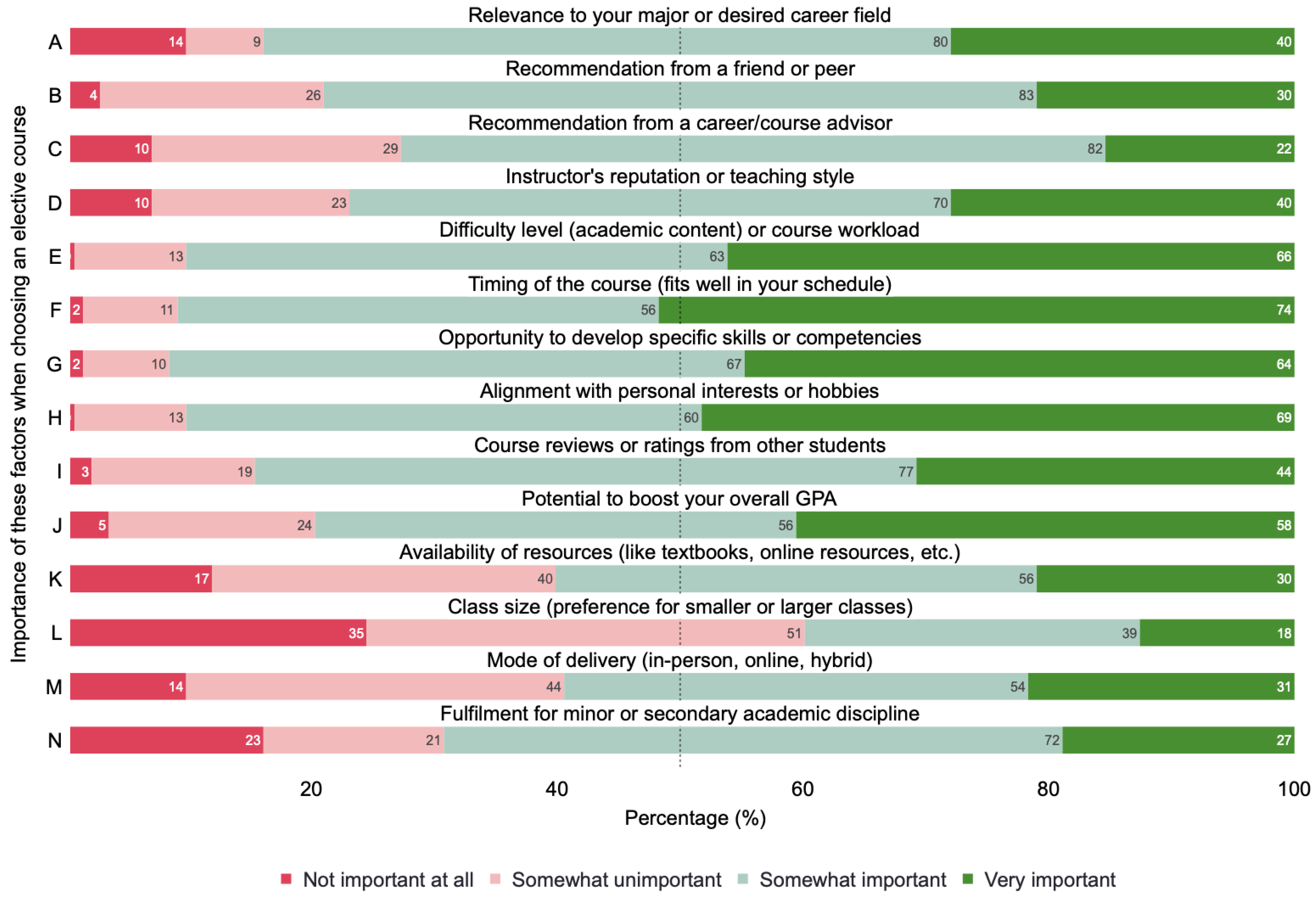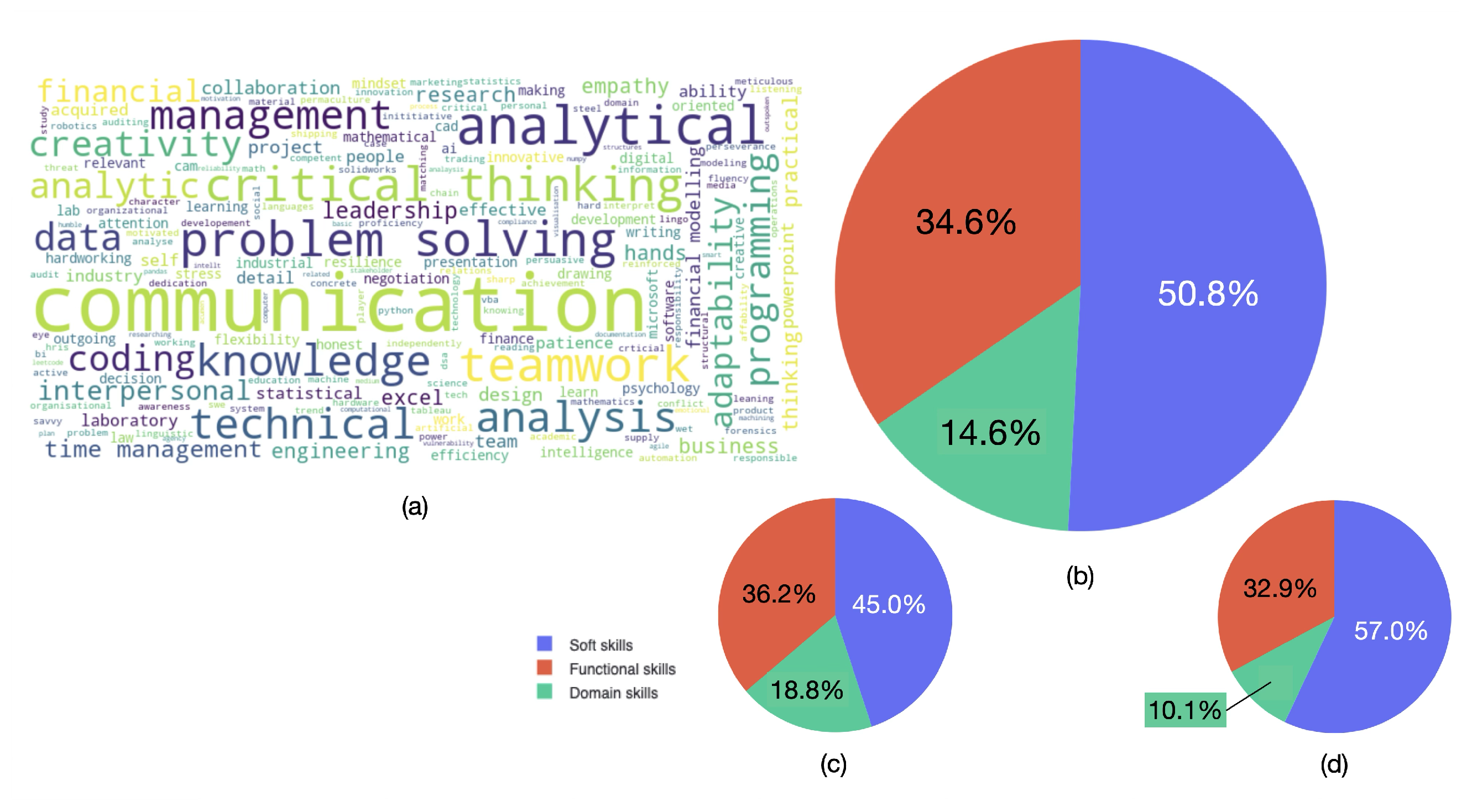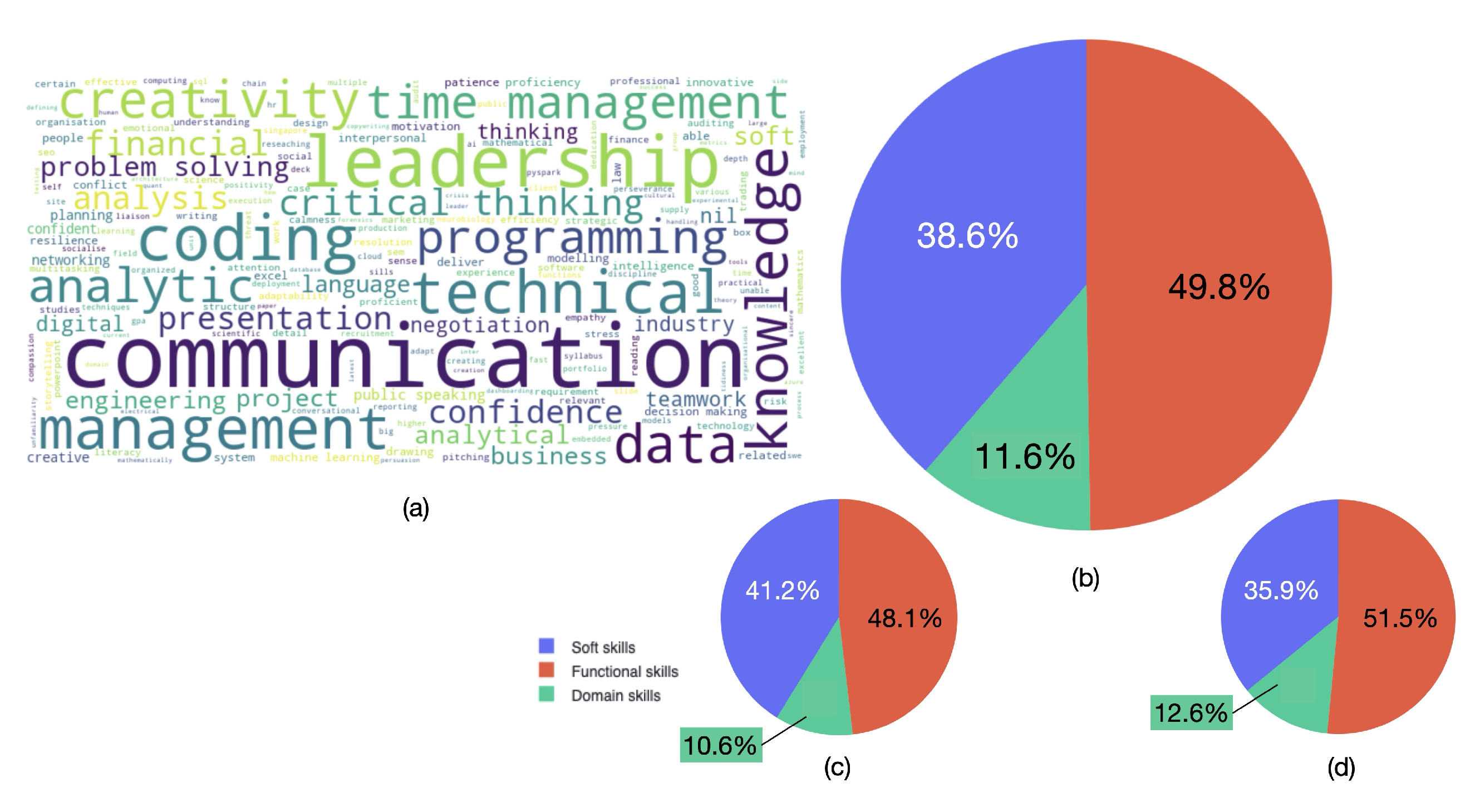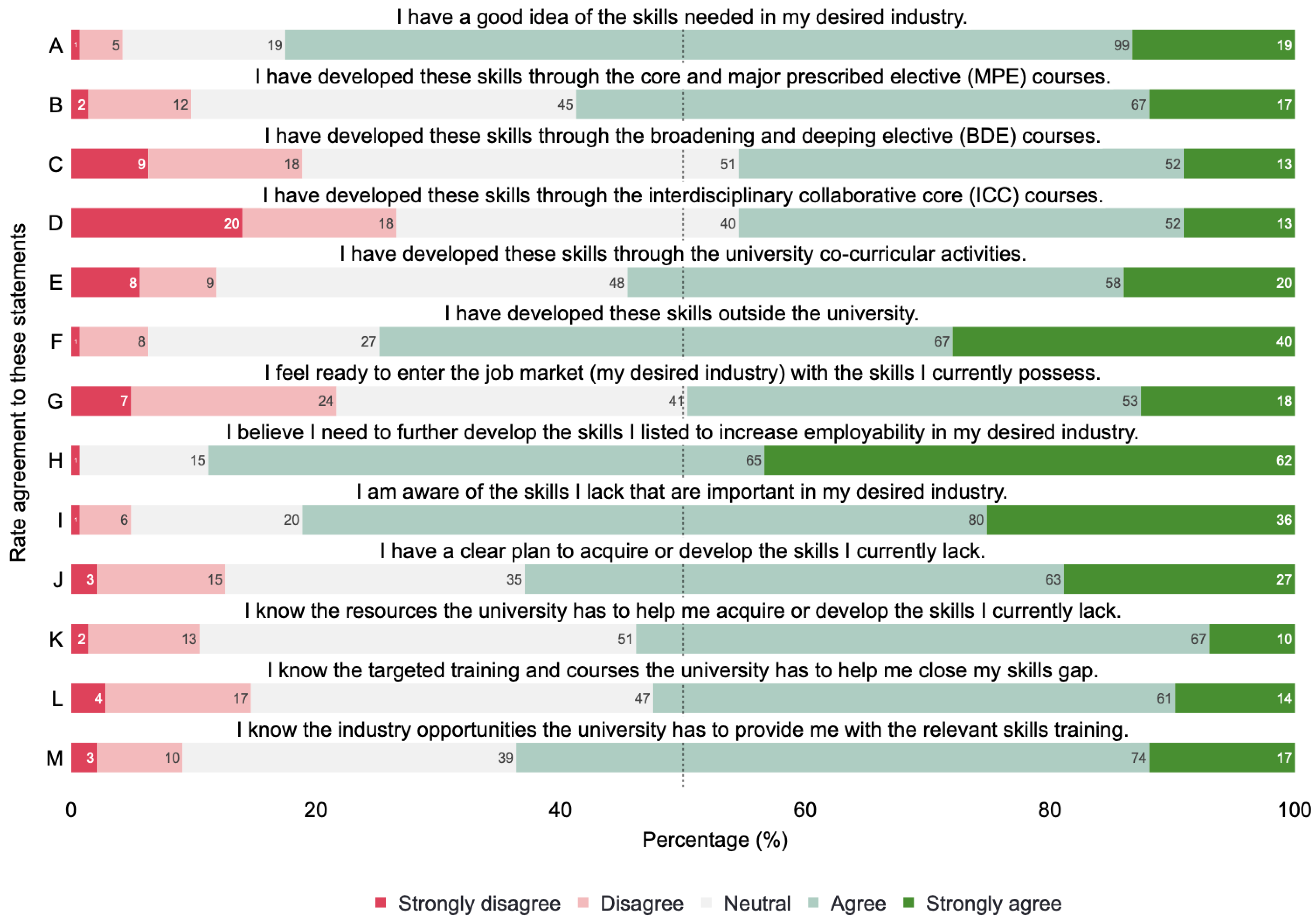Learning Analytics for Bridging the Skills Gap: A Data-Driven Study of Undergraduate Aspirations and Skills Awareness for Career Preparedness
Abstract
1. Introduction
2. Literature Review
3. Methodology
- Section 1: Participant Information and Consent. This section is designed to collect participant information and to ensure informed consent. This section aims to comply with ethical standards, confirm eligibility criteria, and ensure that participants understand the study’s purpose and voluntarily agree to participate. This section also identifies the participants’ disciplines, majors, and any minors they are pursuing.
- Section 2: Factors Influencing Course Selection. This section assesses the importance of different factors in students’ decisions to choose non-core courses. Understanding what influences students’ decisions when selecting courses that are not core requirements helps to identify areas where the university could better support students.
- Section 3: Desired Industry and Skill Assessment. This section determines the primary industry in which participants aim to secure their first job after graduation. Additionally, students were prompted to identify the skills they consider important for their desired industry and evaluate their self-perceived readiness and development through various university activities. Lastly, how students perceive employers’ priorities helps in understanding students’ perceptions of employer expectations.
4. Results and Discussion
4.1. Cluster Analysis of Factors Influencing Students’ Course Choices
4.2. Classification Analysis of Perceived Important Skills and Skills Gap
- Soft Skills
- Definition: Non-technical or interpersonal skills crucial for success in the workplace.
- Examples: Communication, teamwork, problem-solving, time management, and adaptability.
- Functional Skills
- Definition: Practical skills that allow individuals to work confidently and effectively.
- Examples: Data analysis, project management, customer service, basic IT skills, and sales techniques.
- Domain Skills
- Definition: Technical or hard skills, specific knowledge, and abilities required in a particular field.
- Examples: Programming languages, accounting, mechanical engineering, graphic design, and clinical research.
- Requirement Skills
- Definition: Mandatory certification or license that a specific job requires.
- Examples: CPA license, teaching certification, driver’s license, medical license, and real estate license.
- (a)
- Between STEM and SHAPE disciplines for important skills
- H0: There is no difference between the field of study when identifying important career skills.
- (b)
- Between STEM and SHAPE for skills gap
- H0: There is no difference between the field of study when identifying career skills gap.
- (c)
- Between important skills and skills gap within the STEM discipline
- H0: There is no association between the perception of importance and the reported skills gap among STEM students.
- (d)
- Between important skills and skills gap within the SHAPE discipline
- H0: There is no association between the perception of importance and the reported skills gap among SHAPE students.
5. Future Work
6. Conclusions
Author Contributions
Funding
Institutional Review Board Statement
Informed Consent Statement
Data Availability Statement
Acknowledgments
Conflicts of Interest
Appendix A. Survey Questions
- Q1.1–Q1.3: Demographic questions.
- Q2.1: This question is about the degree of importance of these factors when choosing an elective course. [1—not important at all, 2—somewhat unimportant, 3—somewhat important, 4—very important].
- A:
- Relevance to your major or desired career field
- B:
- Recommendation from a friend or peer
- C:
- Recommendation from a career/course advisor
- D:
- Instructor’s reputation or teaching style
- E:
- Difficulty level (academic content) or course workload
- F:
- Timing of the course (fits well in your schedule)
- G:
- Opportunity to develop specific skills or competencies
- H:
- Alignment with personal interests or hobbies
- I:
- Course reviews or ratings from other students
- J:
- Potential to boost your overall GPA
- K:
- Availability of resources (like textbooks, online resources, etc.)
- L:
- Class size (preference for smaller or larger classes)
- M:
- Mode of delivery (in-person, online, hybrid)
- N:
- Fulfillment for minor or secondary academic discipline
- Q3.1: Which industry is the FIRST (1st) choice for your first job after graduation?
- Accounting and Audit
- Aerospace and Aviation
- Agriculture
- Banking and Finance
- Biomedical Sciences
- Chemicals
- Commodity and Natural Resources
- Consumer Business
- eCommerce
- Education
- Energy
- Engineering and Manufacturing
- Food, Beverages, and Tobacco
- Healthcare
- Hospitality and MICE
- Information and Communication Technology
- Insurance
- Logistics
- Management and HR Consulting
- Maritime and Shipping
- Media and Marketing
- Non-Profit
- Oil and Gas
- Public Service
- Real Estate, Building and Construction
- Research and Development
- Retails Trade
- Transportation
- Utilities
- Water and Environment
- Wholesale Trade
- Others
- Q3.2: For my desired first choice, the skills that are important (in my opinion) are: [please give 3 skills]
- Q3.3: This question is about your response to Q3.1 and Q3.2. Please rate your agreement with the following statements:
- A:
- I have a good idea of the skills needed in my desired industry.
- B:
- I have developed these skills through the core courses.
- C:
- I have developed these skills through the elective courses.
- D:
- I have developed these skills through the interdisciplinary courses.
- E:
- I have developed these skills through the university co-curricular activities.
- F:
- I have developed these skills outside the university.
- G:
- I feel ready to enter the job market (my desired industry) with the skills I currently possess.
- H:
- I believe I need to further develop the skills I listed to increase employability in my desired industry.
- I:
- I am aware of the skills I lack that are important in my desired industry.
- J:
- I have a clear plan to acquire or develop the skills I currently lack.
- Q3.4: The important skills that I currently lack are: [please give 3 skills]
- Q3.5: Based on your response to Q3.4, how do you know these are important skills?
- Q3.6: Please rate your agreement with the following statements:
- K:
- I know the resources the university has to help me acquire or develop the skills I currently lack.
- L:
- I know the targeted training and courses the university has to help me close my skills gap.
- M:
- I know the industry opportunities the university has to provide me with the relevant skills training.
- Q3.7: Rank the following skill groups, in order of importance, according to how you perceive employers will rank them. [1—most important, 4—least important].
- Soft skills
- Functional skills
- Domain skills
- Requirement skills
References
- Afzal, A., Khan, L., Hussain, M. Z., Zulkifl Hasan, M., Mustafa, M., Khalid, A., Awan, R., Ashraf, F., Khan, Z. A., & Javaid, A. (2024, April 5–7). Customer segmentation using hierarchical clustering. 2024 IEEE 9th International Conference for Convergence in Technology (I2CT) (pp. 1–6), Pune, India. [Google Scholar] [CrossRef]
- Akosah-Twumasi, P., Emeto, T. I., Lindsay, D., Tsey, K., & Malau-Aduli, B. S. (2018). A systematic review of factors that influence youths career choices—The role of culture. Frontiers in Education, 3, 58. [Google Scholar] [CrossRef]
- Altbach, P., Reisberg, L., & Rumbley, L. (2019). Trends in global higher education: Tracking an academic revolution. Brill. [Google Scholar]
- Andrews, J., & Higson, H. (2008). Graduate employability, ‘soft skills’ versus ‘hard’ business knowledge: A european study. Higher Education in Europe, 33(4), 411–422. [Google Scholar] [CrossRef]
- Artess, J., Hooley, T., & Mellors-Bourne, R. (2017). Employability: A review of the literature 2012 to 2016 (Tech. Rep.). The Higher Education Academy. [Google Scholar]
- Baird, A. M., & Parayitam, S. (2019). Employers’ ratings of importance of skills and competencies college graduates need to get hired: Evidence from the New England region of USA. Education + Training, 61(5), 622–634. [Google Scholar] [CrossRef]
- Banerjee, M., & Bingen, K. (2024). A case for equity in experiential learning: Work-based learning as a viable alternative to internships. Experiential Learning and Teaching in Higher Education, 7(4). [Google Scholar]
- Bridgstock, R. (2009). The graduate attributes we’ve overlooked: Enhancing graduate employability through career management skills. Higher Education Research & Development, 28(1), 31–44. [Google Scholar] [CrossRef]
- Cai, Y. (2012). Graduate employability: A conceptual framework for understanding employers’ perceptions. Higher Education, 65(4), 457–469. [Google Scholar] [CrossRef]
- Castleman, B., & Meyer, K. (2019). Financial constraints & collegiate student learning: A behavioral economics perspective. Daedalus, 148(4), 195–216. [Google Scholar] [CrossRef]
- Ciaramella, A., Nardone, D., & Staiano, A. (2020). Data integration by fuzzy similarity-based hierarchical clustering. BMC Bioinformatics, 21(S10), 350. [Google Scholar] [CrossRef] [PubMed]
- Cover, T., & Hart, P. (1967). Nearest neighbor pattern classification. IEEE Transactions on Information Theory, 13(1), 21–27. [Google Scholar] [CrossRef]
- Cranmer, S. (2006). Enhancing graduate employability: Best intentions and mixed outcomes. Studies in Higher Education, 31(2), 169–184. [Google Scholar] [CrossRef]
- Donald, W. E., Ashleigh, M. J., & Baruch, Y. (2018). Students’ perceptions of education and employability: Facilitating career transition from higher education into the labor market. Career Development International, 23(5), 513–540. [Google Scholar] [CrossRef]
- Figueiredo, H., Biscaia, R., Rocha, V., & Teixeira, P. (2015). Should we start worrying? Mass higher education, skill demand and the increasingly complex landscape of young graduates’ employment. Studies in Higher Education, 42(8), 1401–1420. [Google Scholar] [CrossRef]
- Fix, E., & Hodges, J. L. (1989). Discriminatory analysis. Nonparametric discrimination: Consistency properties. International Statistical Review/Revue Internationale de Statistique, 57(3), 238. [Google Scholar] [CrossRef]
- Fonseca, J. R. (2012). Clustering in the field of social sciences: That is your choice. International Journal of Social Research Methodology, 16(5), 403–428. [Google Scholar] [CrossRef]
- Franke, T. M., Ho, T., & Christie, C. A. (2011). The chi-square test: Often used and more often misinterpreted. American Journal of Evaluation, 33(3), 448–458. [Google Scholar] [CrossRef]
- Gomez, K., & Beachum, F. D. (2019). The “voice” of children of poverty: Candid insights to their career aspirations and perceptions of self-efficacy. The Urban Review, 51(5), 724–747. [Google Scholar] [CrossRef]
- González-Romá, V., Gamboa, J. P., & Peiró, J. M. (2016). University graduates’ employability, employment status, and job quality. Journal of Career Development, 45(2), 132–149. [Google Scholar] [CrossRef]
- Gottfredson, L. S. (1981). Circumscription and compromise: A developmental theory of occupational aspirations. Journal of Counseling Psychology, 28(6), 545–579. [Google Scholar] [CrossRef]
- Goulart, V. G., Liboni, L. B., & Cezarino, L. O. (2021). Balancing skills in the digital transformation era: The future of jobs and the role of higher education. Industry and Higher Education, 36(2), 118–127. [Google Scholar] [CrossRef]
- Jackson, D. (2018). Developing graduate career readiness in Australia: Shifting from extra-curricular internships to work-integrated learning. International Journal of Work-Integrated Learning, 19(1), 23–35. [Google Scholar]
- Kayyali, M. (2024). Career development in higher education: Best practices and innovations. In Advancing student employability through higher education (pp. 1–19). IGI Global. [Google Scholar] [CrossRef]
- Kiuru, N., Salmela-Aro, K., Nurmi, J. -E., Zettergren, P., Andersson, H., & Bergman, L. (2012). Best friends in adolescence show similar educational careers in early adulthood. Journal of Applied Developmental Psychology, 33(2), 102–111. [Google Scholar] [CrossRef]
- Knight, P. T., & Yorke, M. (2003). Employability and Good Learning in Higher Education. Teaching in Higher Education, 8(1), 3–16. [Google Scholar] [CrossRef]
- Kurlaender, M., & Hibel, J. (2018). Students’ educational pathways: Aspirations, decisions, and constrained choices along the education lifecourse. In Handbook of the sociology of education in the 21st century (pp. 361–384). Springer International Publishing. [Google Scholar] [CrossRef]
- Lai, J. W., Zhang, L., Chan, Y. S., Sze, C. C., & Lim, F. S. (2024, March 4–6). Compelling educational offerings: A study on the efficacy of skills identification platforms with course descriptions. INTED2024 Proceedings, Valencia, Spain. [Google Scholar] [CrossRef]
- Lee, Y., Lee, G., Kim, J., & Lee, M. (2021). Equity in career development of high school students in South Korea: The role of school career education. Education Sciences, 11(1), 20. [Google Scholar] [CrossRef]
- Li, I. W., & Jackson, D. (2023). Influence of entry pathway and equity group status on retention and the student experience in higher education. Higher Education, 87(5), 1411–1431. [Google Scholar] [CrossRef]
- Li, L. (2022). Reskilling and upskilling the future-ready workforce for industry 4.0 and beyond. Information Systems Frontiers, 26, 1697–1712. [Google Scholar] [CrossRef]
- Mann, H. B., & Whitney, D. R. (1947). On a test of whether one of two random variables is stochastically larger than the other. The Annals of Mathematical Statistics, 18(1), 50–60. [Google Scholar] [CrossRef]
- Murtagh, F., & Contreras, P. (2011). Algorithms for hierarchical clustering: An overview. WIREs Data Mining and Knowledge Discovery, 2(1), 86–97. [Google Scholar] [CrossRef]
- Nidheesh, N., Nazeer, K. A. A., & Ameer, P. M. (2019). A Hierarchical Clustering algorithm based on Silhouette Index for cancer subtype discovery from genomic data. Neural Computing and Applications, 32(15), 11459–11476. [Google Scholar] [CrossRef]
- Olsen, M., Olsson, M. I. T., Parks-Stamm, E. J., Kvalø, M., Thorsteinsen, K., Steffens, M. C., & Martiny, S. E. (2022). What do I want to be? Predictors of communal occupational aspirations in early to middle childhood. International Journal of Behavioral Development, 46(6), 528–541. [Google Scholar] [CrossRef]
- Osborne, N., & Grant-Smith, D. (2017). Resisting the ‘employability’ doctrine through anarchist pedagogies & prefiguration. Australian Universities ’Review, 59, 59–69. [Google Scholar]
- Pirim, H., Ekşioğlu, B., Perkins, A. D., & Yüceer, u. (2012). Clustering of high throughput gene expression data. Computers & Operations Research, 39(12), 3046–3061. [Google Scholar] [CrossRef]
- Rong, Y., & Liu, Y. (2020, June 27–29). Staged text clustering algorithm based on K-means and hierarchical agglomeration clustering. 2020 IEEE International Conference on Artificial Intelligence and Computer Applications (ICAICA) (pp. 124–127), Dalian, China. [Google Scholar] [CrossRef]
- Rungruang, C., Riyapan, P., Intarasit, A., Chuarkham, K., & Muangprathub, J. (2024). RFM model customer segmentation based on hierarchical approach using FCA. Expert Systems with Applications, 237, 121449. [Google Scholar] [CrossRef]
- Singapore Department of Statistics. (2020). Singapore standard industrial classification 2020 (Tech. Rep.). Department of Statistics, Ministry of Trade & Industry, Republic of Singapore. Available online: https://www.singstat.gov.sg/-/media/files/standards_and_classifications/industrial_classification/ssic2020report.ashx (accessed on 12 January 2023).
- Singha, R., Singha, S., & Jasmine, E. (2024). The Intersection of Academics and Career Readiness. In Preparing students from the academic world to career paths (pp. 246–266). IGI Global. [Google Scholar] [CrossRef]
- Smith, C., & Worsfold, K. (2013). Unpacking the learning–work nexus: ‘Priming’ as lever for high-quality learning outcomes in work-integrated learning curricula. Studies in Higher Education, 40(1), 22–42. [Google Scholar] [CrossRef]
- Steffy, K. (2017). Willful versus woeful underemployment: Perceived volition and social class background among overqualified college graduates. Work and Occupations, 44(4), 467–511. [Google Scholar] [CrossRef]
- Taunk, K., De, S., Verma, S., & Swetapadma, A. (2019). A Brief Review of Nearest Neighbor Algorithm for Learning and Classification. In 2019 international conference on intelligent computing and control systems (iccs) (pp. 1255–1260). IEEE. [Google Scholar] [CrossRef]
- Tymon, A. (2013). The student perspective on employability. Studies in Higher Education, 38(6), 841–856. [Google Scholar] [CrossRef]
- Ward, J. H. (1963). Hierarchical grouping to optimize an objective function. Journal of the American Statistical Association, 58(301), 236–244. [Google Scholar] [CrossRef]
- Watts, A. G. (2006). Career development learning and employability (Tech. Rep.). The Higher Education Academy. [Google Scholar]
- Wilton, N. (2012). The impact of work placements on skills development and career outcomes for business and management graduates. Studies in Higher Education, 37(5), 603–620. [Google Scholar] [CrossRef]
- Winterton, J., & Turner, J. J. (2019). Preparing graduates for work readiness: An overview and agenda. Education + Training, 61(5), 536–551. [Google Scholar] [CrossRef]
- Yang, W., Wang, X., Lu, J., Dou, W., & Liu, S. (2021). Interactive steering of hierarchical clustering. IEEE Transactions on Visualization and Computer Graphics, 27(10), 3953–3967. [Google Scholar] [CrossRef]
- YouScience. (2022). State of the future U.S. workforce: Student ability report (Tech. Rep.). YouScience. [Google Scholar]





| N | (%) a | |
|---|---|---|
| Participants | 143 | 100.0 |
| STEM | 74 | 51.7 |
| Sciences | 24 | 16.8 |
| Engineering | 30 | 21.0 |
| Data Science | 20 | 14.0 |
| SHAPE | 69 | 48.3 |
| Humanities and Social Sciences | 26 | 18.2 |
| Business | 43 | 30.1 |
| Cluster # | STEM Cluster Members | Mean Rating | SHAPE Cluster Members | Mean Rating |
|---|---|---|---|---|
| 1 | A, B, C, D | B, C, D | ||
| 2 | F, K, L, M, N | G, H, I, J, K | ||
| 3 | G, H | E, F, L, M | ||
| 4 | E, I, J | A | ||
| 5 | - - - | - - - | N |
| Important Skills | Skills Gap | |||
|---|---|---|---|---|
| Skill Type | STEM | SHAPE | STEM | SHAPE |
| Soft | 98 | 118 | 89 | 71 |
| Functional | 79 | 68 | 104 | 102 |
| Domain | 41 | 21 | 23 | 25 |
| Requirement | 0 | 0 | 0 | 0 |
| H0 | -Statistic | df | p-Value | Significance () |
|---|---|---|---|---|
| (a) | 2 | Significant | ||
| (b) | 2 | Not Significant | ||
| (c) | 2 | Significant | ||
| (d) | 2 | Significant |
| Rank | ||||
|---|---|---|---|---|
| Skill Type | 1 | 2 | 3 | 4 |
| Soft | 51 | 37 | 27 | 28 |
| Functional | 28 | 39 | 54 | 22 |
| Domain | 30 | 28 | 39 | 46 |
| Requirement | 34 | 39 | 23 | 47 |
Disclaimer/Publisher’s Note: The statements, opinions and data contained in all publications are solely those of the individual author(s) and contributor(s) and not of MDPI and/or the editor(s). MDPI and/or the editor(s) disclaim responsibility for any injury to people or property resulting from any ideas, methods, instructions or products referred to in the content. |
© 2025 by the authors. Licensee MDPI, Basel, Switzerland. This article is an open access article distributed under the terms and conditions of the Creative Commons Attribution (CC BY) license (https://creativecommons.org/licenses/by/4.0/).
Share and Cite
Lai, J.W.; Zhang, L.; Sze, C.C.; Lim, F.S. Learning Analytics for Bridging the Skills Gap: A Data-Driven Study of Undergraduate Aspirations and Skills Awareness for Career Preparedness. Educ. Sci. 2025, 15, 40. https://doi.org/10.3390/educsci15010040
Lai JW, Zhang L, Sze CC, Lim FS. Learning Analytics for Bridging the Skills Gap: A Data-Driven Study of Undergraduate Aspirations and Skills Awareness for Career Preparedness. Education Sciences. 2025; 15(1):40. https://doi.org/10.3390/educsci15010040
Chicago/Turabian StyleLai, Joel Weijia, Lei Zhang, Chun Chau Sze, and Fun Siong Lim. 2025. "Learning Analytics for Bridging the Skills Gap: A Data-Driven Study of Undergraduate Aspirations and Skills Awareness for Career Preparedness" Education Sciences 15, no. 1: 40. https://doi.org/10.3390/educsci15010040
APA StyleLai, J. W., Zhang, L., Sze, C. C., & Lim, F. S. (2025). Learning Analytics for Bridging the Skills Gap: A Data-Driven Study of Undergraduate Aspirations and Skills Awareness for Career Preparedness. Education Sciences, 15(1), 40. https://doi.org/10.3390/educsci15010040







